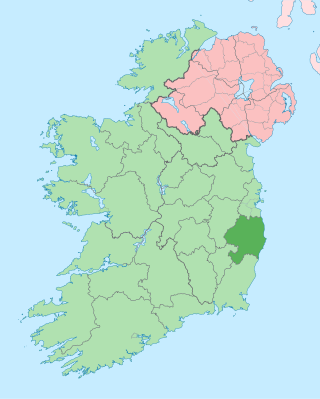
County Wicklow is a county in Ireland. The last of the traditional 32 counties, having been formed as late as 1606, it is part of the Eastern and Midland Region and the province of Leinster. It is bordered by the Irish Sea to the east and the counties of Wexford to the south, Carlow to the southwest, Kildare to the west, and South Dublin and Dún Laoghaire–Rathdown to the north.
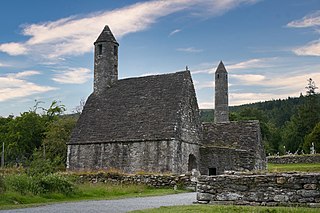
Glendalough is a glacial valley in County Wicklow, Ireland, renowned for an Early Medieval monastic settlement founded in the 6th century by St Kevin. From 1825 to 1957, the head of the Glendalough Valley was the site of a galena lead mine. Glendalough is also a recreational area for picnics, for walking along networks of maintained trails of varying difficulty, and also for rock-climbing.

Newgrange is a prehistoric monument in County Meath in Ireland, located on a rise overlooking the River Boyne, 8 kilometres (5.0 mi) west of Drogheda. It is an exceptionally grand passage tomb built during the Neolithic Period, around 3200 BC, making it older than Stonehenge and the Egyptian pyramids. It is aligned on the winter solstice sunrise. Newgrange is the main monument in the Brú na Bóinne complex, a World Heritage Site that also includes the passage tombs of Knowth and Dowth, as well as other henges, burial mounds and standing stones.
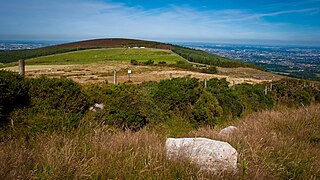
Kilmashogue or Kilmashoge is a mountain in Dún Laoghaire–Rathdown county in Ireland. It is 408 metres high and forms part of the group of hills in the Dublin Mountains which comprises Two Rock, Three Rock, Kilmashogue and Tibradden Mountains. The forest plantation on its northern slope, which is composed mainly of Sitka spruce, Scots pine and beech, is a habitat for Sika deer, hares, rabbits and foxes. A number of prehistoric monuments can be found on the slopes of the mountain.
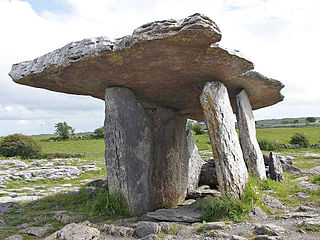
Poulnabrone dolmen is an unusually large dolmen or portal tomb located in the Burren, County Clare, Ireland. Situated on one of the most desolate and highest points of the region, it comprises three standing portal stones supporting a heavy horizontal capstone, and dates to the Neolithic period, probably between 4200 BC and 2900 BC. It is the best known and most widely photographed of the approximately 172 dolmens in Ireland.

Labbacallee wedge tomb is a large pre-historic burial monument, located 8 km (5.0 mi) north-west of Fermoy and 2 km (1.2 mi) south-east of Glanworth, County Cork, Ireland. It is the largest Irish wedge tomb and dates from roughly 2300 BC. The tomb is a National Monument in State Care no. 318. It was the first megalithic tomb in the country to be described by an antiquarian writer, in John Aubrey’s manuscript of 1693.

Two Rock is a mountain in Dún Laoghaire–Rathdown, Ireland. It is 536 metres high and is the 382nd highest mountain in Ireland. It is the highest point of the group of hills in the Dublin Mountains which comprises Two Rock, Three Rock, Kilmashogue and Tibradden Mountains. The mountain takes its name from the two granite tors that lie to the south-east of the summit. From the summit, which is called Fairy Castle, there are views of much of the Dublin area from Tallaght to Howth to the north while Bray Head, Killiney Hill, the Great Sugar Loaf and the Wicklow Mountains are visible to the south. The summit area is mostly shallow bog while ferns and gorse cover the lower slopes. The mountain is also an important habitat for red grouse.

Kilnaboy or Killinaboy is a village, townland and civil parish in County Clare, Ireland. It is located in the Burren, and as of the 2011 census the area had 347 inhabitants.

Aghanaglack or Aghnaglack, is a townland in County Fermanagh, Northern Ireland. It is situated in the civil parish of Boho, as well as Fermanagh and Omagh district.

Kilbride, or Manor Kilbride, is a village, civil parish and electoral division in County Wicklow, Ireland, located at the western edge of the Wicklow Mountains in the barony of Talbotstown Lower.

The Piper's Stones or the Athgreany stone circle is a Bronze Age stone circle at Athgreany, County Wicklow. It sits on a low hillock overlooking the N81, 2 km south of Hollywood.
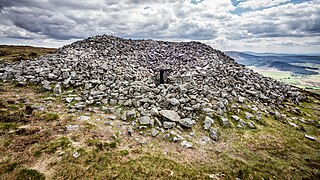
Seefin Passage Tomb is an empty passage grave and National Monument located atop Seefin Hill, County Wicklow, Ireland.

Corracloona Court Tomb, commonly called Prince Connell's Grave, is a chamber tomb and National Monument located in the north of County Leitrim in the West of Ireland.
Carricknagat Megalithic Tombs are megalithic tombs and a National Monument located in County Sligo, Ireland.
Cabragh Wedge Tomb, also called Cabragh I or the Giant's Grave, is a wedge-shaped gallery grave and National Monument located in County Sligo, Ireland.
Doorus Demesne wedge tomb is a wedge-shaped gallery grave and National Monument located in County Galway, Ireland.
Tullycommon Wedge Tomb is a wedge-shaped gallery grave and National Monument located in The Burren region of County Clare, Ireland.

Altar Wedge Tomb is a wedge-shaped gallery grave and National Monument located outside the village of Schull, in County Cork, Ireland.

Island Wedge Tomb is a wedge-shaped gallery grave and National Monument located southeast of Mallow in County Cork, Ireland.

Carrownlisheen Wedge Tomb is a wedge-shaped gallery grave and National Monument located on Inishmaan, Ireland.

















